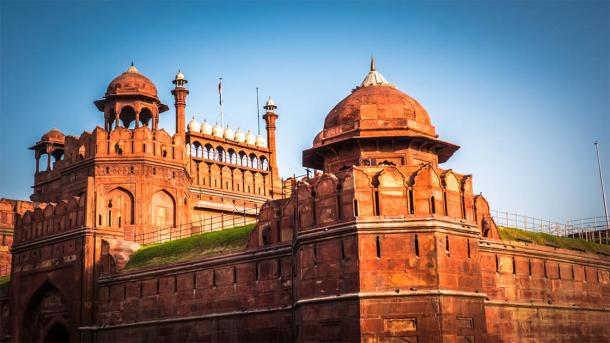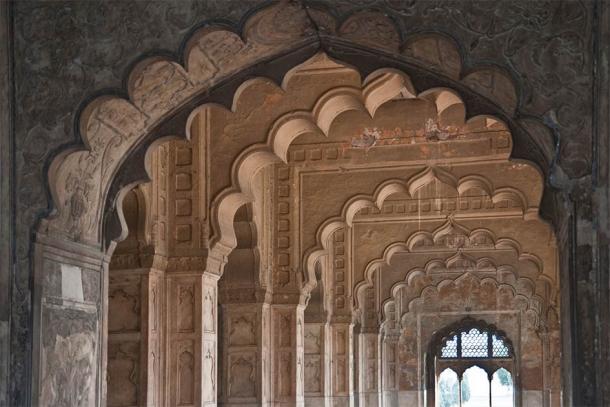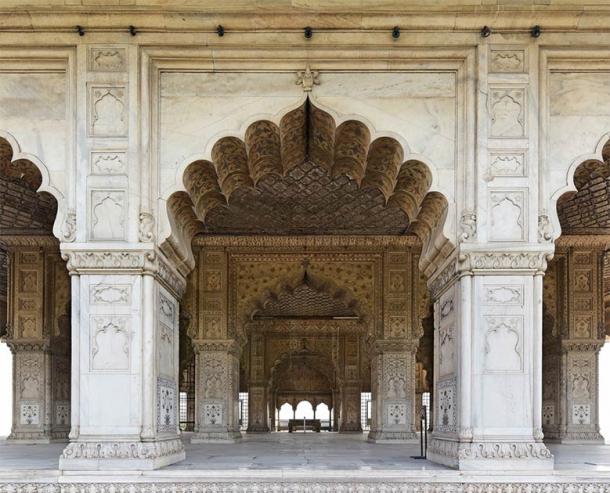For various reason, buildings and structures become symbols of nations, for example the Eiffel Tower in Paris, the pyramids in Egypt, and the Red Fort in New Delhi, India. Also known as Lal Qalʿah, the Red Fort was the center of Indian government for centuries and is still a symbol of power. This UNESCO World Heritage site is rich in history and contains many architectural wonders. It is incredibly popular with both locals and visitors.

Red Fort in Old Delhi India ( Vivvi Smak / Adobe Stock)
The Dramatic History of the Red Fort
A fortress was first built at the site in the 12 th century. The Red Fort, however, was built on the orders of the Mughal Emperor Shah Jahan in the 1630s, and was designed by Ustad Ahmad Lahori, the architect who designed the Taj Mahal . The fort soon became the heart of Old Delhi.
The fort contained the court and the private residence of the Emperor, inhabited by Mughal royalty, officials, and their families. Many of the treasures of India were held at the site, including artworks, gold and gems. The fort was expanded by Muhi-ud-Din Muhammad, more commonly known as Aurangzeb, the last great Mughal ruler.
After 1700 AD the Mughals declined. In 1739, Nadir Shah, the Shah of Iran , sacked Delhi and looted the palace, stealing the famous Peacock Throne. After the Third Battle of Panipat, the Marathas captured the fort, but the Mughal Emperor remained in titular control of New Delhi. After the Maratha War, the British took New Delhi and used the fort as an administration center.

The intricate and beautiful interior of the Red Fort ( Detlef / Adobe Stock)
During the Indian Mutiny (1857-1859) rebels seized the fort and the last Mughal emperor who resided here became the symbol of the rebellion. However, it was retaken by the British and the last of the Mughal dynasty was sent into exile. The Red Fort became a symbol of the British Raj , who restored some buildings damaged in the mutiny.
Several important political trials were held in the fort, including those of the members of the Indian National Army who had sided with the Japanese in WWII. In 1947, Jawaharal Nehru declared Indian a sovereign nation. The Red Fort continued to be used as a fort by the Indian Army until 2003. Every Independence Day, the Prime Minister gives a speech at the fort.
Details of the Red Fort in New Delhi
The architecture of the Red Fort complex is a mixture of Persian, Timurid, and Hindu styles. Massive red sandstone walls rise up to 75 feet tall (22 m) and extend for a mile and a half (2.3 km). They are adorned with turrets and bastions of varying heights.

Red fort wall in New Delhi, India, aerial drone view ( Roman / Adobe Stock)
The area is octagonal and one side of it runs parallel to the Yamuna River. The main Lahore Gate, so named because it faces the city of Lahore in Pakistan, was used by the general public and it is here that Nehru declared Indian independence. The Delhi Gate, situated in the southern wall, is three stories high and is flanked by two life-size statues of elephants.
Adjacent to the Lahore Gate is the Chhatta Chow bazaar with its barrel vault roof. Beyond this is the Naubat Khana or waiting hall, where people assembled before entering into court and where music and festivities were often held. The most famous structure in the complex, the Diwan-i-Aam, was the audience hall where people were received by Shah Jahan and his successors. Sixty red sandstone pillars support a vast flat roof.

The pillars and interior of Diwan-i-Khas in historic Red Fort. The once-silver ceiling has been restored in wood. ( Zoran Karapancev / Adobe Stock)
A pavilion called Diwan-i-Khas is where the Mughal emperors would receive petitioners, or hold private audiences, while seated on the famous Peacock Throne , the fate of which has never been confirmed. Nearby is a step-well, baths and a mosque that was built by Aurangzeb.
The Hira Mahal (Diamond Palace) is a pavilion that was built by the last Mughal monarch. His study, the so-called Emperor Tower, is at present being restored. Among the other sights at the historic complex are the women’s quarters and the ‘princes’ quarter’ that consists of a precinct within the complex where members of the royal family resided.
An older fort that was built by the short-lived Suri dynasty in 1546, and other monuments located on the grounds, are collectively known as the Red Fort complex.
Visiting the Royal Fort in New Delhi
The fort is in the heart of New Delhi and is open to members of the public. A fee is charged to enter, and guided tours are available. To appreciate all the marvelous buildings, a three-hour tour is advised. The state of the buildings is mixed, and some are better preserved than others.
Top image: Agra fort, or Red fort, Delhi, India. Source: Lukas
By Ed Whelan
References
Asher, C., Asher, C. B., Asher, C. E. B., & Asher, C. B. (1992). Architecture of Mughal India (Vol. 4). Cambridge University Press
Leasor, J. (2014). The Red Fort . James Leasor Publishing.
Sharma, K. (2011). A Symbol of State Power: Use of the Red Fort in Indian Political Trials . In Ethics, Evil, Law and the State: State Power and Political Evil (pp. 29-37). Brill
Available at: https://brill.com/view/book/edcoll/9781848880771/BP000005.xml
Related posts:
Views: 0
 RSS Feed
RSS Feed
















 August 22nd, 2020
August 22nd, 2020  Awake Goy
Awake Goy  Posted in
Posted in  Tags:
Tags: 
















